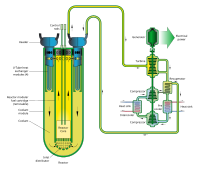
Photo from wikipedia
Abstract Evaluating the effects of soil and water conservation on the Chinese Loess Plateau (CLP) during the past 60 years depends mainly on understanding the historical processes of soil erosion fluxes… Click to show full abstract
Abstract Evaluating the effects of soil and water conservation on the Chinese Loess Plateau (CLP) during the past 60 years depends mainly on understanding the historical processes of soil erosion fluxes and their mechanism. However, little was known about the historical variation in soil erosion and its driving factors due to the lack of few ideal geological carriers on the CLP. A representative Heshui (HS) landslide-dammed reservoir that formed 200 years ago was drilled with a 31.39 m length sediment sequence. The HS sequence was composed of 165 deposition couplets with 56 annual freeze–thaw layers based on the elemental distributions by X-ray fluorescence core scanners. Mean couplet and annual specific sediment yields (CSSY and ASSY) were 1.44 × 104 t/km2 and 1.28 × 104 t/km2/yr, respectively. The HS sequence was deposited over CE 1811–1996, which was dated by multi-methods crossing among 137Cs activities, annual freeze–thaw layers, CSSY, recent rainfall records, and historical flood index grades. Besides, the threshold value of hydrological events that generated sediments in the HS reservoir was greater than 40 mm. As a result, there were eight periods of high ASSY between CE 1811 and 1996, although the total tendency of the ASSY was decreased, especially under the management of soil and water since the 1960s on the CLP. Interannual change of monsoon storms under El Nino-Southern Oscillation events was the primary factor affecting the variations in ASSY and storms in the HS region. Besides, human activities, such as policies and wars, also had significant influences on the historical soil erosion processes in this region. These results not only shed light on the historical changes in soil erosion fluxes and corresponding hydrological events during the past 200 years in the plateau-gully area of the CLP, but the active mechanisms under the different driving factors were also better understood.
Journal Title: Catena
Year Published: 2021
Link to full text (if available)
Share on Social Media: Sign Up to like & get
recommendations!